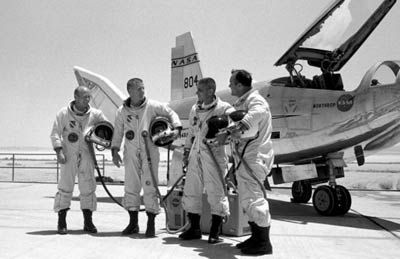Human factors in commercial suborbital flight: The limits of supplemental oxygenby John Jurist
|
| A full pressure suit is extremely expensive: currently over $1 million, and over $3 million for a true spacesuit capable of EVA. |
Actually, a person can go above about 12,200 meters (40,000 feet) by breathing pure oxygen at a higher pressure than the ambient pressure, but the effort is exhausting, has negative effects on the body, and only gains a few thousand feet before the required excess pressure becomes so great as to be dangerous.
At higher ambient altitudes, the solution is to wear either a partial or a full pressure suit. A full pressure suit is extremely expensive: currently over $1 million, and over $3 million for a true spacesuit capable of EVA. (This is a potential business opportunity for the right type of alt.space enthusiast.)
What about cabin depressurization? We are all familiar with potential use of supplemental oxygen with cabin depressurization in aircraft. What about spacecraft depressurization? If the cabin occupants are in shirtsleeves, the depressurization better be reversed quickly. What if the occupants are wearing pressure suits? Because of mobility concerns, pressure suit designers prefer to keep the pressure differential between the inside and the outside of the suit as small as possible. The shuttle EVA-type suit is pressurized to about 222 mm Hg, but it is purged with oxygen before use and the suit occupant must breathe oxygen for a period before using the suit in order to minimize the chances of developing decompression sickness (otherwise known as the bends, the chokes, or aeroembolism). The old Skylab suits were pressurized to about 200 mm Hg.
Since at least one existing alt.space company is considering the use of pressure suits for its passengers, prior military experience with these devices is relevant. Survey of more than 400 U-2 pilots found that many reported symptoms of decompression sickness during their careers, and more than 10 percent reported that they altered or aborted their missions as a result. Most symptoms disappeared on return to the ground and breathing pure oxygen for a limited period. The U-2 cabin environment was designed to maintain an equivalent altitude of 8,800–9,100 meters (29,000–30,000 feet), with the pilot wearing a pressure suit capable of maintaining an altitude of 10,700 meters (35,000 feet) and breathing pure oxygen during the flight and for a one hour period prior to the flight. Risk factors for developing decompression sickness include the effective exposure altitude, the rate of change of pressure to the exposure altitude, and fatigue, dehydration, and obesity. Incomplete washout of nitrogen during the preflight period of breathing oxygen is also a risk factor. Risks of decompression sickness in the general population have not been well characterized, and this is one of the factors for the spacecraft designer to consider.
| It is reasonable to assume that future passenger-carrying commercial spacecraft will at least ultimately be required to provide for some type of backup (such as pressure suits during launch and reentry) in case of depressurization. |
The old partial-pressure suits suffered from extreme wearer discomfort as wearing time increased. Heat dissipation was a great problem. The newer full-pressure suits utilize liquid-cooled undergarments for heat control. Spacesuit design is another set of problems we will consider later. Some members of the alt.space community have experimented with used pressure suits purchased from the old USSR. The viability of this approach is highly suspect for a variety of reasons that are beyond the scope of this column.
Present commercial aircraft require a backup system in case of cabin depressurization (supplemental oxygen). It is reasonable to assume that future passenger-carrying commercial spacecraft will at least ultimately be required to provide for some type of backup (such as pressure suits during launch and reentry) in case of depressurization. Keep in mind that commercial aircraft can reach survivable atmospheric air pressure in a very short time in case of emergency, while a suborbital spacecraft is not. It is committed to the ballistic part of its trajectory from the latter portion of the rocket motor burn until it gets back down to breathable air. This process can take many minutes in the event of cabin depressurization during the burn and, depending on when depressurization was to occur, is well beyond the ability of a passenger to survive without a pressure suit.
The past few columns have touched upon some of the issues related to cabin environment. The problem of carbon dioxide absorption and humidity management is not as significant in suborbital flight as in orbital flight, but still exists. Other issues, such as accumulation of assorted toxic gases and vapors in cabin air, and growth of various bacteria, molds, and fungi in the cabin environment will be touched upon in discussions of orbital flight and beyond.
The potential problems of decompression sickness go beyond the preceding discussion. For example, symptoms covering the spectrum from discomfort to disabling pain result from expanding gases within the body (gastrointestinal system, ears, and even teeth) during rapid depressurization. We have not considered these problems, but they exist.
The next few columns will consider the effects of acceleration, and then some failure scenarios and how one might possibly deal with them.
